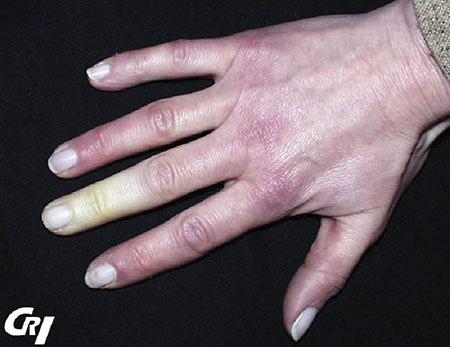Raynaud’s phenomenon, or syndrome, is a transient blood circulation disorder in the extremities, affecting the fingers, sometimes the toes, and more rarely the nose or ears. It can be aggravated by certain drugs with vasoconstrictive activity, that is, causing the arteries of the extremities to close.
The signs appear in episodes, during which the affected skin territories become brutally white (syncopal phase) (see adjacent photo) and become numb before going through a purplish phase (asphyxic phase) and then turn red (hyperemic phase, indicating the return of circulation in the vessels that relax). Painful tingling, pulsations and numbness, with or without loss of sensitivity, are often associated.
Common in the general population (one in 10 people), it is found more frequently during lupus (about 20 to 30 out of 100 patients) where it remains benign, and without consequences.
What are the triggers?
Most often, this phenomenon is triggered by an exposure to cold that leads to vasoconstriction (tightening of small vessels by exaggerated contraction of their wall). Other triggering factors are known: intense emotion, stress, vibrations (repetitive and regular handling of vibrating mechanical tools such as jackhammer). This phenomenon is aggravated by tobacco.

Raynaud's phenomenon is more common in people with lupus than in the general population. It is characterised by a sudden and brief blood circulation disorder in the fingers or toes. Signs usually appear as a result of exposure to cold. The affected areas then turn white and become numb. This is usually a benign phenomenon. Some preventive drugs can reduce the discomfort caused by the Raynaud's phenomenon, but the first treatment is physical protection against the cold (gloves, heaters, socks ...).